Since social and environmental challenges posed by the highly volatile, uncertain and complex world will mainly impact upon the young, schools need to instill in their graduates a set of critical-thinking, problem-solving, decision-making, strategy-building, and communication skills in order for students to be informed and engaged citizens. This paper postulates that in higher education institutions (HEIs), this can be achieved through fostering motivation and student autonomy. Academic posters are proposed as one of the relevant tools allowing educators to adopt an autonomy-supportive style of teaching that leads to enhanced independence, interest, and responsibility for social affairs. At their core, academic poster projects facilitate academic skills, including information processing, reading, writing, presenting, and defending ideas. Embracing in-depth research and enhanced social dialogue in lessons, they pinpoint leading ideas of the current young generation and as such can predict the topics of the future. Academic poster projects can be adopted in general subjects, as well as in language teaching, thus providing educators with a potent tool to achieve broad educational goals.
1 Educational challenges
The main challenges of the 21st century can only be tackled with involved, informed, and responsible citizens. Active citizenship, therefore, should be developed in schools, and an engaged citizen should be, in turn, the ultimate goal of the educational process. This paper aims at proposing approaches to how the process of education, one of the main institutions on the way to a student’s maturity, can contribute to achieving this goal.
1.1 Student motivation and autonomy
The first prerequisite leading to students’ active engagement in social affairs is their motivation to learn. Motivation, a basic force which prompts human actions toward pursuing goals, had first been described in the context of employee job satisfaction and their stimuli for work and higher performance, in which reward systems are developed accordingly (e.g., Herzberg 1959; Maslow 1954; McClelland 1984; McGregor 1960). Motivation has no smaller significance in the field of education.
Motivation and respective reward systems both at work and in school generally distinguish between two basic approaches: extrinsic motivational factors that utilize external tools to reward or punish, such as salary, policies, benefits and working conditions in the context of employment, or evaluation and grading, deadlines, praise, or reprimand in the context of ed education, and intrinsic motivational factors, which build upon internal will and desires, such as achievement, advancement, recognition, responsibility, or autonomy to name a few. Needless to say that all these are generally applicable to both employment as well as studies. Research also confirms that while the extrinsic factors bring fast satisfaction, only the intrinsic truly motivate and drive achievement and self-actualization long-term.
Researchers on motivation in education confirms this (Assor et al. 2005; Clifford 1990; Deci, Koestner and Ryan 2001; Reeve 2009; Reeve, Deci and Ryan 2004; Reeve and Jang 2006; Ryan and Deci 2000). While recognizing the internal and external motivational factors in the controlling and autonomy-supportive styles of teaching and student leadership, data shows (Reeve 2009:159) that „students tend to suffer when teachers control their behavior”, but they „educationally and developmentally benefit when teachers support their autonomy”. In this respect, controlling is seen as imposing the teacher’s perspective on how the students should „think, feel, or behave in a specific way”, which frequently results in students’ resignation and passivity. The autonomy-supportive style, on the other hand, is proposed to better “identify, nurture, and develop students’ inner motivational resources” and support their self-regulation in learning.
Teachers, nonetheless, still seem to delay implementing the autonomy-supportive style into their practices. This delay is believed to result from the controlling style being more easily measurable because exact criteria for reward and punishment are used, while the autonomy-supportive tools aimed at awakening student desires for self-actualization and esteem are hard to be quantified and their results are visible only in the long run (Reeve 2009). The autonomy-supportive style frequently gives rise to uncertainty in teachers and also pressure or impatience from parents. Therefore, it requires strong teacher leadership, confidence, and school support.
Educational transformation is a long-term process demanding systematic effort promoted from both the authorities as well as from within. This paper postulates the use of academic posters in teaching practices as one of the possible tools to enforce student autonomy which can ultimately lead to student internal motivation for learning, interest in social affairs and active social engagement not only on a national but also global scale.
1.2 Academic poster as a multi-purpose educational tool
Posters have a long history (Le Coultre and Purvis 2002) dating back to the rise of the printing industry. Ever since then, they have been used in many fields, such as marketing and advertisement, politics and activism, or art and architecture, to name a few. One of the general purposes of posters is to communicate a message to the public within the public space. However, posters are used in academia, too. The purpose of academic posters is to summarize information or research in order to publicize projects or ideas, generate discussions about specific topics in a clear, reader-friendly and attractive way, and network in order to foster trans-institutional and transnational cooperation.
Academic posters (Figure 1) require academic skills. They carry standard academic procedures and structure, including literature reviews, adoption of multiple research methods, presentation of data analysis results, as well as a conclusion. Posters combine textual and visual information, such as graphs and charts, tables, or pictures. To communicate their message efficiently to the audience, like any other poster, academic posters need to be elaborated in a concise and attractive manner.
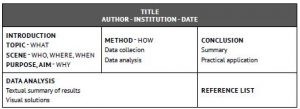
Figure 1: Academic poster structure
Source: Author
Academic posters are typically presented at conference poster sessions or research fairs. Authors display their posters and present them in an allocated time in person to an audience. Poster sessions open opportunities for other participants to walk around, view, interact, and network. The authors deliver short presentations and answer questions posed by visiting colleagues. Posters, thus, represent a potent tool for developing research and study skills, academic and professional writing, as well as key communication competences including discussion, argumentation, and presentation. They also represent a comprehensive method for language education. As such, posters can prepare learners well not only for succeeding in their academic efforts or competing and succeeding on the job market but also in handling future social challenges. This tool, therefore, has great potential in education.
Academic posters have a universal use across the educational ladder and subjects. In primary or secondary education, they can help teach students how to present ideas in a structured way and develop study skills necessary to succeed in the higher levels of education. At the tertiary level, they teach them how to conduct and structure research, write academic texts and present results within individual subjects and expert fields. Academic posters also function as an ideal tool for language education as they fit into a modern approach to language teaching known as Content and Language Integrated Learning (CLIL) (Morgado et al. 2015), a holistic approach teaching foreign languages through content and contextualization. The approach is now widely adopted by higher education institutions (HEI) in programs or professional subjects taught through foreign language instruction. As such, poster projects promote students’ autonomy (Holec 1981; Little 2008; Little, Dam and Legenhausen 2017; Robertson 2013) in language learning as students can choose topics of individual interests and continue in guiding their further study on their own.
This paper proposes that academic posters not only have a potential to develop professional skills of students in higher education but that they can also motivate students toward active citizenship as not only national, but also international citizens. Henceforth, posters are studied from two perspectives: educational and social. They are on the one side presented as a tool to activate students’ interest in social local as well as global topics, gain autonomy in their professional development, motivate and train them for research they have embarked upon themselves, and to open a platform for sharing ideas and debate. At the same time, posters are put forward as a mirror of the social climate of a given generation of students as they reveal concerns and issues the students consider urgent or looming. Serving both the educational and social goal, academic posters are proposed to be a mirror into the future issues and challenges.
2 Methodology
The study was conducted at the ŠKODA AUTO University, a private higher education institution (HEI) located in Mladá Boleslav, the Czech Republic, founded by a multinational industrial company. The school offers business administration and industrial management program in a full-time and combined study form at the bachelor’s and master’s degree. The data for this paper were collected in a business English language course focused on economics, as one of the mandatory English language modules in the school’s master’s degree language program. The research project presented through academic posters represent the main course requirements worth 60% of the students’ final grade. The poster projects aim at developing a set of student study and communication skills as students are required to conduct both primary and secondary research, analyze data, and draw conclusions within a topic of their choice which they then elaborate through textual and visual information in the form or a poster (30 of 60%), submit along with an abstract of 200 words (10 of 60%), and finally, share and defend it in front of an audience through an oral presentation (20 of 60%) followed by a discussion. The topics of the academic posters are not assigned, students choose them on their own from a wide range of macro- or microeconomic themes. This approach thus gives the students a unique chance to pursue topics of their own interest.
Two hundred and eight poster topics collected between the fall of 2014 and summer of 2020 completed by students specializing in finances, management and marketing, human resources or logistics were categorized into topic areas and analyzed. The goal of the analyses was to pursue the students’ scope of interests in social topics as an indicator of both their social engagement and themes likely to set the tone for social challenges and issues in the future. It is also believed that giving the students freedom to choose their topics can boost their interest and autonomy, thus prepare them for efficient active engagement.
3 Poster topic analyses
Out of the 208 posters collected over the course of 12 semesters, the analysis revealed a set of six main topical areas (Figure 2), which will be organized according to the frequency of occurrence and further discussed under the following categories: (1) ecology (31%); (2) ethics (22%); (3) economy (15%); (4) car industry (14%); (5) health and lifestyle (10%), and (6) politics (8%). Each category will be further analyzed for subtopics and then implications will be drawn as some topics are cross-sectional, overlap over the whole data set as well as change over time. The choice and specialization of the topics then indicate significant conclusions for both the field of education as well as the social sector.
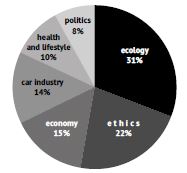
Figure 2: Student topics by theme areas
Source: Author
3.1 Topic area 1: Ecology
As seen from the Figure 3, ecological topics dominate, comprising more than 31% of all data (64/208). The most frequently elaborated ecology subtopics address such issues as plastic waste (e.g., plastics in the ocean, ocean pollution, plastic recycling, overuse of plastics and harmful effects of plastics). Students also choose varied topics concerning climate change (e.g., global warming, CO2 emissions, animal and agriculture emissions, greenhouse effect, ozone layer, melting glaciers and water supply). An equivalent degree of interest is invested into topics related to deforestation, while topics referring to bushfires in Australia and South America, tree felling and controlled burning, desertification or water resources and drought tend to overshadow the earlier dominant topics related to harmful effects of palm oil production. Animal extinction (e.g., coral bleaching, collapsing bee colonies, shark finning and disappearing species) is a perennial topic.
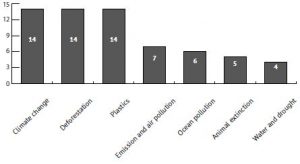
Figure 3: Ecology sub-topics
Source: Author
3.2 Topic area 2: Ethics
Ethics represented in about 22% of the topics (46/208) turns out to be another dominating issue of the students’ concern (Figure 4), while controversial corporate practices and their social role take the lead. Students frequently analyze and evaluate corporate social responsibility programs of popular global brands, such as Starbucks, McDonalds, or Coca Cola, as well as particular fair-trade initiatives within various market segments such as the clothing, cosmetic, or food industry (e.g., coffee or tea). Some raise issues concerning labor conditions in developing countries (e.g., the sweatshops in Cambodia or India). Recently, growing attention to the issue of the widening inequality gap can be observed (in the context of corruption, taxation policies or Covid-19).

Figure 4: Ethics sub-topics
Source: Author
3.3 Topic area 3: Economy
Students general interest in varied economy related issues, which cover almost 15% of the poster topics (30/208), is likely affected by the fact economics is their study field. Therefore, subtopics also vary the most (Figure 5) as students can draw upon a variety of other school subjects. A considerable number of posters address taxation policies (flat vs. progressive tax, electronic revenue records, value-added tax) and some topics slightly overlap with the earlier discussed ethical issues (e.g., tax heavens, the Panama papers scandal). Consumer behavior is a popular topic, too, covering themes such as consumer decisions, purchasing behaviors, Covid-19 spending habits, managing unpredictability and investment incentives. Students also study the pros and cons of the common European currency, the euro, in the Czech Republic. The remaining topics address the structure of the labor market, cryptocurrencies, and government funding of various sectors such as sport or culture, to name a few.
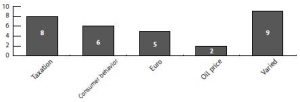
Figure 5: Economy sub-topics
Source: Author
3.4 Topic area 4: Car industry
Car industry is the topic of roughly 14% of the poster projects (29/208), a finding which can be partially attributed to the school’s close relationship to the automotive sector and the working opportunities the school’s students have through manifold school internship opportunities. Students can apply for work with companies from the VW Group during their mandatory internship in their 5th semester at the bachelor’s level and facultative internships during their master’s studies, an opportunity which many of them exploit. Nonetheless, the structure of the car-industry related subtopics (Figure 6) still reflects the students’ general concerns and interests in the context of wider social affairs. The majority of the subtopics address the question of ecology, including electric mobility and its potential to address the ecological challenges for the future, followed by topics discussing the question of lowering emissions, and complemented by pursuing the potential of hydrogen cars. Only a few of the topics relate to technologies, driverless cars, or legal and safety issues.
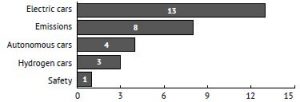
Figure 6: Car industry sub-topics
Source: Author
3.5 Topic area 5: Health and lifestyle
At the first glance, the approximate 10% occurrence (21/208) of the health and lifestyle topics (Figure 7) may seem to overlap with ecological or other topic areas. Indeed, most of the topics in this category refer to managing waste and recycling. The few discussing a vegetarian lifestyle perceive a vegetarian diet as ecologically beneficial, thus as a potential solution to climate change, or they define vegetarianism as an ethical issue. Students are, however, also directly concerned about health issues, as reflected in topics discussing the negative impacts of low-quality food, excess use of sugar or smoking. The prospective category, however, contains an important consideration as it indicates the students’ readiness to adopt their lifestyle for the sake of solving the issues their generation is likely to be facing in the future.

Figure 7: Health and lifestyle sub-topics
Source: Author
3.6 Topic area 6: Politics
Quite a few topics covering slightly over 8% of the topic set (18/208) relate to political issues (Figure 8), which indicates the students’ interest in social issues and political decisions made by a country’s elected representatives. Typically, students show their interest in current social affairs and the way they should be approached by the politicians, as the time they chose topics such as migration or Brexit corresponds with the time these issues occurred. Related to that, students also discuss demographic questions, such as population development (e.g., world overpopulation vs. depopulation trends in Europe or Japan), or address topics related to potential threats to democracy (e.g., world terrorism, populism).

Figure 8: Politics sub-topics
Source: Author
4 Summary
As indicated throughout the analysis of the chosen topic areas, the selected topics could be assessed from a variety of perspectives as they indicate a number of cross-sectional themes. For example, ecological concerns permeate more than 50% (105/208) of the data. They are obviously also addressed within the car industry topic area (e.g., electric cars (13), lowering emissions (8) or hydrogen cars (3)), within the health and lifestyle topic area (e.g., waste and recycling (11) or vegetarian diets (3)), or even within the political topic area (e.g., population growth (3)). Similarly, ethical issues occur even more frequently, covering as much as 55% of the data set (115/208) as they are also addressed within the ecological topic area (e.g., deforestation (14), plastic pollution (14), ocean pollution (6) or animal extinction (5)), within the car industry topic area (autonomous cars (4)), within the health and lifestyle section (e.g., waste and recycling (11) or vegetarianism (3)) or even within selected political topics (e.g., migration (6) or threats to democracy (6)).
Of course, health and lifestyle topics seem widely covered, in the end constituting 57% (119/208) of the posters as many of the other topic area issues assume a necessary change in the way people live if the civilization challenges are meant to be seriously faced. Changing lifestyles would need to be adopted to solve the ecological issues (e.g., climate change (14) plastic pollution (14)) and the ethical issues (e.g., clothing (7) or cosmetic industry (5)). Similarly, personal choices go along with car-industry related changes (e.g., electric cars (13), hydrogen cars (3) or combustion engines (8)). Finally, lifestyles are shaped by political decisions (e.g., democracy (6), population (3), or migration (3)) as well as affected by various economy related phenomena (e.g., consumer behavior (7) or the acceptance of the euro in the Czech Republic (5)).
Last but not least, it may seem students’ interest in political issues is rather low given that they represent in only 8% of the overall topic set. However, a concealed reference to politics can be traced in most of the topics, especially when students draw their conclusions or recommendations for implementation. Students in their conclusions suggest solutions to the ecological issues, as they very much relate to the governments and related policies in a global scope, including adopting climate change measures, or making decisions to stop deforestation, plastic pollution, lowering emissions, or protecting animals, water or the oceanic biosphere. The same applies in the ethical topic area as political representations makes decisions for policies related to corporations within varied industry sectors, fair trade, labor issues, or inequality. Likewise, taxation policies or the adoption of the European common currency count as political decisions, as well as many of the issues related to car industry topics because they closely link to strategic decisions regarding emission limits or the national as well as global environmental strategies tackling the climate issues. The health and lifestyle topics are not an exception, as national policies determining waste management, or the quality of food have a considerable impact on human health. Seen from this perspective, the vast majority of the topics can be in the end considered political.
4.1 Conclusions and implications
Criticism of the young generation, its lifestyles and sense of responsibility frequently resonate through the public discourse. This fact can be demonstrated by a statement from one of the prominent Czech intellectuals who published the following remark in an online daily news journal: „I am telling the young that they will die of hunger, but with a beautiful mobile phone” (Cílek 2020). This study, however, shows that students are neither ignorant nor negligent in what are the challenges of their future if they are given a voice. The data show their high awareness and interest in ecological issues, ethical issues, and thanks to their close and frequently internal contact to the automotive industry, they also pose questions to the quality of environment and search solutions to lower emission and find alternative sources of energy for transportation. They, at the same time, show an awareness of macro-economic and political issues which frequently overlap with the current affairs and decisions made on a political level, proving their engagement with the actual social issues. Last but not least, the students seem to realize the need to adopt their lifestyles to tackle the ecological, ethical, and social challenges of the current era. As such, their projects indicate the social topics these students’ generation is likely to face in the coming years.
Besides the potential of giving students autonomy, high degree of responsibility and freedom to choose the area of their interest which leads to enhanced curiosity, motivation and engagement in wider social affairs, this study also shows that implementing academic posters into the teaching practices can have additional and multiple potential in the students’ personal and professional development. First, through the academic poster project, they learn important study and work habits which are crucial for their future chances in the job market. Specifically, they need to adopt conscious planning and time management and develop their technical skills by using IT tools and applications to design their posters. Through independent research, students get a chance to dive into collecting expanding information from various resources. They learn how to identify, sort, evaluate, and critically assess resources and data. They get experience in data collection and analysis, including using various tools of qualitative and quantitative research. They develop their analytical thinking and learn how to synthesize information into clear conclusions. They develop their critical thinking, and this growth in their intellectual capacity leads to suggesting solutions, proposing strategies, or making responsible decisions.
Second, academic posters develop the whole communication skill set. The students practice reading and academic writing techniques. They learn how to present their ideas, argue, negotiate , and answer questions during their presentations and debates. And they learn how to compete and ‘sell’ their research ideas or topic interests to their colleagues and teachers.
Third, implementing the poster projects into language courses represents a potent tool for modern education. The CLIL approach adopted at the language department of the ŠKODA AUTO University was first introduced in the late 1980s (Morgado et al. 2015) when it integrated the leading ideas and findings from earlier concepts in the field of language teaching and methodologies. It draws upon the communicative approach (Brumfit and Johnson 1991; Littlewood 1994; Widdowson 1978) introduced in the 1970s, which unlike the earlier used grammar-translation or audio-oral methods, emphasized a balanced development of all language competences with by the aim to develop skills to use foreign languages in practical social situations. The natural approach introduced in the early 80-ies (Krashen and Terrell 1983) can be traced in the accent on learning through immersion into natural life situations and contexts, like mother tongues get acquired. The CLIL approach also accentuates the functional and pragmatic use of foreign languages over formal and grammatical precision, as later described in the lexical approach (Lewis 1993), SLA studies (Firth 2009; Firth and Wagner 1997) and ELF (English as a Lingua Franca) research (Cogo and Dewey 2006; Jenkins 2007; Mauranen 2006; Seidlhofer 2005). It also aims at reaching „global intercultural competence”, as inscribed in BELF (Business English as a Lingua Franca) (Louhiala-Salminen and Kankaanranta 2011; Pullin 2013; Pullin 2015). Last but not least, CLIL allows for a learner-centered and collaborative approach described in the Reading and Writing through Critical Thinking initiative (RWCT) (http://www.rwctic.org/) as it teaches languages through contextual problem-solving, decision-making, planning, and strategizing with reinforced student engagement. Along with similar concepts like the Content-Based Instruction (CBI) (Brinton at al. 1989) or Task-Based Instruction (TBI) (Ellis 2003), CLIL represents a holistic approach by teaching foreign languages through content and contextualization, and as such has been lately widely adopted by higher education institutions (HEI) in programs teaching professional subjects through foreign language instruction.
To conclude, a close look into the topics the students select for their poster projects when given autonomy to freely choose shows not only their awareness of the current issues, but also their readiness for active engagement. It also indicates that the young generation should be taken as a serious partner for tackling the upcoming social challenges, as they are nor ignorant, nor negligent of their future. Their teachers, on the other hand, using academic posters as a tool to teach them necessary skills for the 21st century can help students handle the challenges they will be tackling in their prospective lives.
Literatúra/List of References
- Assor, A., Kaplan, H., Kanat-Maymon Y. and Roth, G., 2005. Directly controlling teacher behaviors as predictors of poor motivation and engagement in girls and boys: The role of anger and anxiety. In: Learning and Instruction. 2005, 15(5), 397-413. ISSN 0959-4752.
- Brinton, D. M., Snow, M. A. and Wesche, M. B., 1989. Content-based second language instruction. New York: Newbury House, 1989.
- Brumfit C. and Johnson, K. (eds.), 1991. The communicative approach to language teaching. Oxford University Press, 1991, 5-26.
- Cílek, V., 2020. Mladým říkám, že umřou hlady, ale s nádherným mobilem. In: Novinky.cz. 2020, 9(18).
- Clifford, M. M., 1990. Students need challenge, not easy success. In: Educational Leadership. 1990, 48(1), 22-26. ISSN 0013-1784.
- Cogo, A. and Dewey, M., 2006. Efficiency in ELF communication: From pragmatic motives to lexico-grammatical innovation. In: Nordic Journal of English Studies. 2006, 5(2), 59-94. ISSN 1654-6970.
- Deci, E. L., Koestner, R. and Ryan, R. M., 2001. Extrinsic rewards and intrinsic motivation in education: Reconsidered once again. In: Review of Educational Research. 2001, 71(1), 1-27. ISSN 1747-938X.
- Ellis, R., 2003. Task-based language learning and teaching. Oxford: Oxford University Press, 2003. ISBN 9780194421591.
- Firth, A. and Wagner, J., 1997. On discourse, communication, and (some) fundamental concepts in SLA research. In: The Modern Language Journal. 1997, 81(3), 285-300. ISSN 1540-4781.
- Herzberg, F., 1966. Work and the nature of man. Cleveland: World Publishing, 1966.
- Holec, H., 1981. Autonomy and foreign language learning. Oxford: Pergamon, 1981. ISBN 9780080253572.
- Jenkins, J., 2007. English as a lingua franca: Attitude and identity. Oxford University Press, 2007. ISBN 9780194422376.
- Krashen, S. D. and Terrell, T. D., 1983. The natural approach: Language acquisition in the classroom. Hayward, CA: Alemany Press, 1983. ISBN 0-13-609934-3.
- Le Coultre, M. F. and Purvis, W. A., 2002. A century of posters. Lund Humphries Pub Ltd. 2002. ISBN 978-0853318637.
- Lewis, M., 1993. The lexical approach. Hove: Language teaching publications, 1993. ISBN 0-906717-0-99-X.
- Little, D., 2008. Language learner autonomy: Some fundamental considerations revisited. In: Innovations in Language Learning and Teaching. 2008, 1(1), 14-29. ISSN 1750-1229.
- Little, D., Dam, L. and Legenhausen, L., 2017. Language learner autonomy: Theory, practice and research. Bristol: Multilingual Matters, 2017. ISBN 9781783098590.
- Louhiala-Salminen, L. and Kankaanranta, A., 2011. Professional communication in a global business context: The notion of global communicative competence.In: IEEE transactions on professional communication. 2011, 54(3), 244-262. ISSN 0361-1434.
- Littlewood, W., 1994. Communicative language teaching. Cambridge University Press, 1994.
- Maslow, A. H., 1954. Motivation and personality. New York: Harper and Row, 1954.
- Mauranen, A., 2006. Signaling and preventing misunderstanding in ELF communication. In: International Journal of the Sociology of Language. 2006, 177, 123-150. ISSN 0165-2516.
- McClelland, D. C., 1985. Human motivation. Glenview, Illinois: Scott, Foresman & Co., 1985.
- McGregor, D., 1960. The human side of enterprise. New York: McGraw-Hill. 1960.
- Morgado, M., Coelho, M., Ribeiro, M. del C. A., Albuquerque, A., da Silva, M., Chorâo, M., Cunha, S., Gonçalves, A., Carvalho, A. I., Régio, M., Faria, S. and Chumbo, I., 2015. CLIL training guide: Creating a CLIL learning community in higher education. Santo Tirso – Portugal: De Facto Editores, 2015. ISBN 978-989-8557-50-6.
- Pullin, P., 2013. From curriculum to classroom: Designing and delivering courses in workplace communication. In: Babylonia. 2013, 2(13), 32-36. ISSN 1420-0007.
- Pullin, P., 2015. Culture, curriculum design, syllabus and course development in the light of BELF. In: Journal of English as a Lingua Franca. 2015, 4(1), 31-53. ISSN 2191-933.
- Ryan, R. M. and Deci, E. L., 2000. Intrinsic and extrinsic motivations: Classic definitions and new directions. In: Contemporary Educational Psychology. 2000, 25(1), 54-67. ISSN 0361-476X.
- Reeve, J., Deci, E. L. and Ryan, R. M., 2004. Self-determination theory: A dialectical framework for understanding the sociocultural influences on student motivation. In: McInerney, D. M. and Van Etten, S. Research on sociocultural influences on motivation and learning: Big theories revisited. Greenwich, CT: Information Age Press, 2004, 4, 31-59. ISBN 9781593110529.
- Reeve, J., 2009. Why teachers adopt a controlling motivating style toward students and how they can become more autonomy supportive. In: Educational Psychologist. 2009, 44(3), 159-175. ISSN 0022-0663.
- Reeve, J. and Jang, H., 2006. What teachers say and do to support students’ autonomy during a learning activity. In: Journal of Educational Psychology. 2006, 98(1), 209-218. ISSN 0022-0663.
- Robertson, Z., 2013. The autonomous language learner. University of Birmingham. 2013.
- Seidlhofer, B., 2005. English as a lingua Franca. In: ELT Journal. 2005, 59(4), 339-341. ISSN 1916-4742.
- Widdowson, H., 1978. Teaching language as communication. Cambridge University Press, 1978. ISBN 9780194370776.
Kľúčové slová/Key words
academic poster, student autonomy, critical-thinking, active citizenship
akademický poster, autonómia študenta, kritické myslenie, aktívne občianstvo
JEL klasifikácia/JEL Classification
I23, M31
Résumé
Marketingové témy prostredníctvom akademických posterov: Cesta k autonómii študentov a aktívnemu občianstvu
Nakoľko sociálne a environmentálne výzvy, ktoré predstavujú veľmi nestály, neistý a zložitý svet, budú mať dopad hlavne na mladých ľudí, školy musia svojim absolventom vštepiť súbor kritického myslenia, riešenia problémov, rozhodovania, budovania stratégie a komunikácie zručnosti, aby študenti boli informovaní a zainteresovaní občania. Tento príspevok predpokladá, že na vysokých školách sa to dá dosiahnuť podporovaním motivácie a autonómie študentov. Akademické postery sa navrhujú ako jeden z relevantných nástrojov, ktoré umožňujú pedagógom prijať štýl výučby podporujúci autonómiu, ktorý vedie k zvýšenej samostatnosti, záujmu a zodpovednosti za sociálne veci. Akademické posterové projekty vo svojej podstate uľahčujú akademické zručnosti vrátane spracovania informácií, čítania, písania, prezentovania a obhajoby myšlienok. Vďaka dôkladnému výskumu a zdokonalenému sociálnemu dialógu na hodinách určujú popredné myšlienky súčasnej mladej generácie a ako také môžu predpovedať témy budúcnosti. Akademické posterové projekty môžu byť prijaté tak vo všeobecných predmetoch, ako aj vo výučbe jazykov, a tak poskytujú pedagógom účinný nástroj na dosiahnutie širokých vzdelávacích cieľov.
Recenzované/Reviewed
16. March 2021 / 18. March 2021












